Audi Elaine and Aicon Concepts: Highly Automated Versus Fully Autonomous
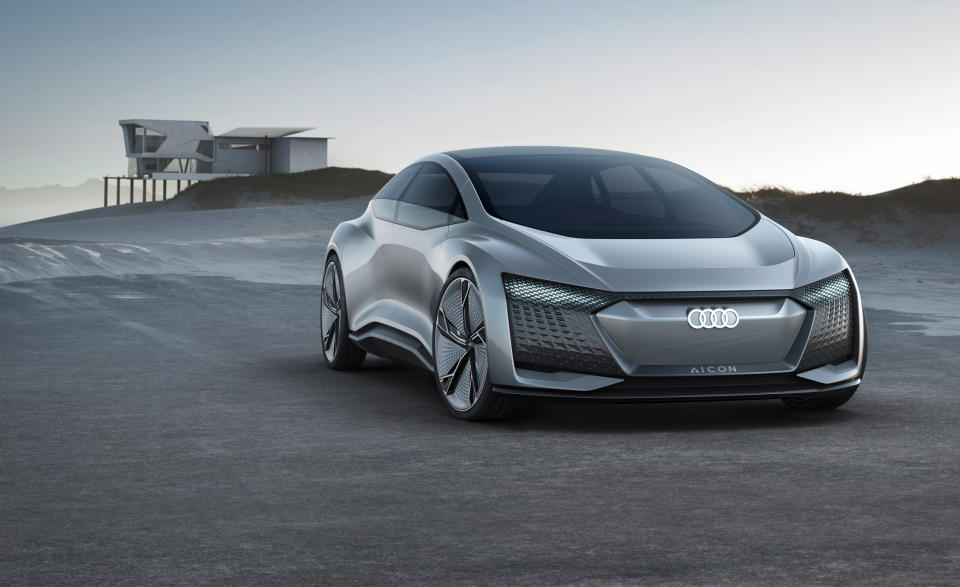
Audi is among the automakers pushing hardest for advances in the development of automated-driving systems. But the transition to the most advanced forms of this tech won’t happen overnight, within a couple of years, or probably even within a decade. So the automaker is smartly using a pair of Frankfurt auto show concept cars to highlight the differences between the short-term goal of conditional automation and the eventual goal of fully computer-driven luxury cars.
The brand’s technology that is here today—soon to make its debut in the 2019 Audi A8, pending government approval—is Traffic Jam Pilot, an SAE Level 3 system that allows the driver to leave steering, braking, following distance, and speed maintenance to the computer systems. It’s still the driver’s responsibility to be ready to take over with only a few seconds’ notice.

Artificial intelligence (AI), simply put, is technology designed to adapt and refine decision-making so that it can anticipate the future. In Audi’s case, its fully networked car already is capable of planning about 10 seconds ahead. These two concept cars, on the other hand, are glimpses of what Audi’s AI-intensive approach could bring in future models that let the driver focus away from driving more—or even all—of the time. (Audi so wants to emphasize AI that the cars’ names both include that letter combination.)
Artificial Intelligence, Pure Electric
The Elaine, which carries over the rakish four-door SUV-coupe exterior of the e-tron Sportback design study Audi displayed earlier this year, is likely to closely resemble the second of three fully electric vehicles due from the brand by 2020, were it to reach production. It features an all-electric drive system bound for future roadgoing models, with one electric motor for the front wheels and two for the rear wheels—delivering 429 horsepower, or 496 in a special mode, which is good for a 62-mph dash in a claimed 4.5 seconds. Battery capacity is 95 kWh, and the concept has both inductive charging and 150-kW fast charging.
On board is a “much more advanced” version of the zFAS controller used in the A8’s Traffic Jam Pilot, permitting pilot-free driving up to 81 mph. This Level 4 automated system includes the ability to initiate lane changes on its own to maintain the desired speed. Inside, controls have been reduced, and touchscreens cover a large area. The car includes vehicle-to-infrastructure (V2X) technology, which helps safety systems perceive hazards earlier. An Audi Fit Driver system monitors vital signs such as body temperature and heart rate and offers guided breathing exercises, seat massage, mood lighting, and climate-control functions adapted to driver conditions. Audi says it aims for the driver to be more relaxed after traveling in the car than ever before.
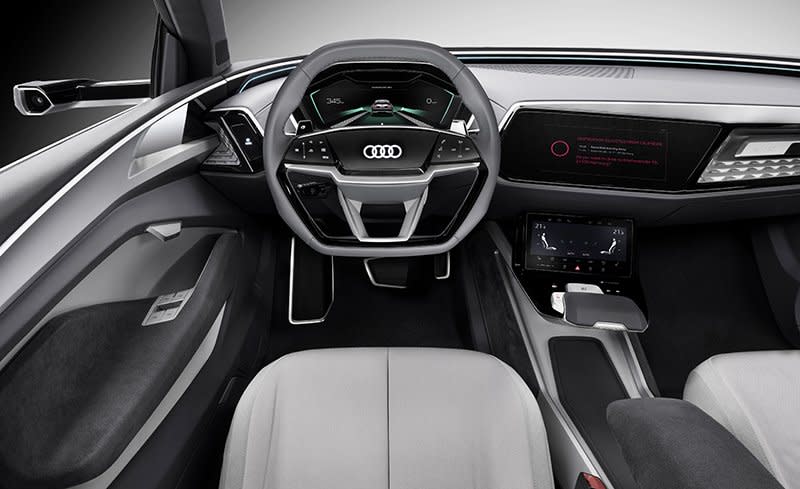
The Elaine is capable of driving itself without the driver or any occupant present in designated private areas termed Audi AI Zones—a multistory parking garage, for instance, where it could park itself, return to the owner, and perform tasks such as getting a carwash. There’s also a Personal Intelligent Assistant (PIA)—essentially a vehicular version of Siri, Alexa, or Google Now—that observes the driver’s behavioral patterns and applies machine-learning methods to make recommendations.
Autonomous Maximus
Audi’s other concept for Frankfurt, called the Aicon, likely is of less interest to drivers than it is to futurists. It shows how future innovations could combine in a fully autonomous vehicle; as an advanced design study, it gives a glimpse of “a prestigious automobile of tomorrow that stirs the desires of demanding customers.”
Everything about the design of this large four-door sedan derives from a vision of the future in which autonomous cars are a given on every street and all road users are connected. It’s a dystopian vision to anyone who appreciates driving, as it purges redundant controls such as the steering wheel. The flip side is that it assumes there will be no collisions, rendering occupant-restraint systems equally obsolete. Whereas airplane cockpits inform traditional driver’s cars, this concept draws its inspiration from a La-Z-Boy ensconced in a classically furnished home. This fully autonomous vehicle nixes conventional instruments in favor of a simple dashboard and a cabin styled for an “impression of antique spaciousness.” The front seats, which Audi says are the automotive reinterpretation of the lounge chair, are upholstered in a square-quilted upholstery and can be swiveled 15 degrees for easier entry and exit. The Aicon has front and rear cargo areas that provide approximately 23 cubic feet of space.
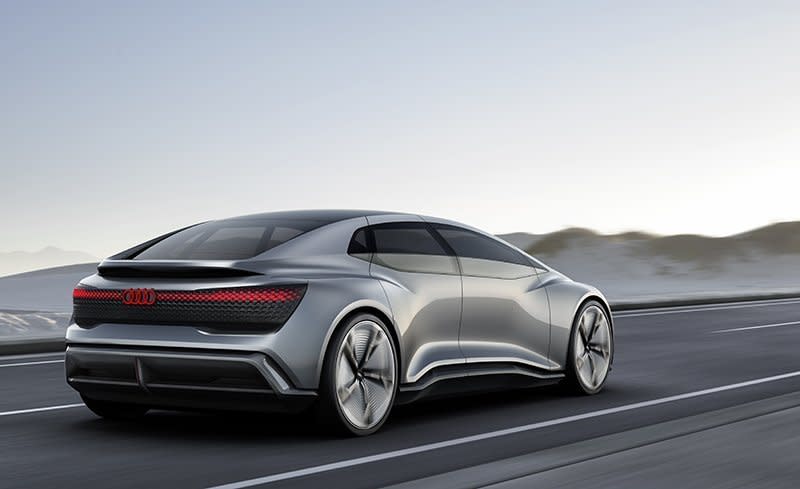
The concept has two-plus-two seating, long expanses of glass that make for a bright interior, and massive 26-inch wheels. It’s 214.3 inches long, 82.7 inches wide, and 59.3 inches high, with a limousine-like 136.6-inch wheelbase, which Audi points out is 9.4 inches longer than that of the long-wheelbase version of the upcoming 2019 A8.
The concept boasts two motors in front and two in back, good for a combined 349 horsepower and 406 lb-ft of torque. While the idea is not yet in production, Audi’s concept also sports some conceptual solid-state batteries that are integrated below the floor to allow a range of nearly 500 miles on a single charge, and with 800-watt ultrafast charging, they would be capable of recovering 80 percent of their capacity in less than 30 minutes.
The engineering and design freedom allowed by autonomous technology is the point of the Aicon, however. While that Quattro all-wheel-drive system will bring strong all-weather traction, the emphasis for suspension tuning is ride comfort, with air springs, dampers, and electric actuators at all four wheels. Because there’s no steering wheel, there’s no steering shaft, and a compact all-wheel-steering system gives the long Aicon an exceptionally tight turning radius of 27.9 feet. With primary braking coming from brake regeneration, the friction disc brakes have been relocated inboard.
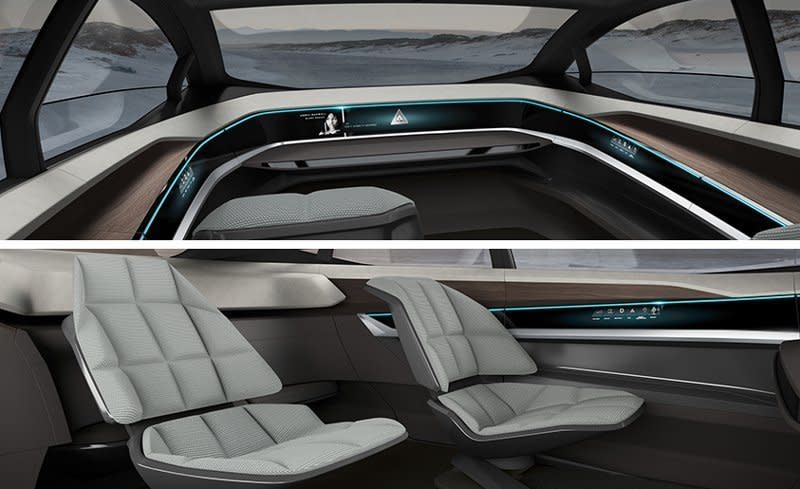
The inverted hexagonal single-frame grille is shared with upcoming electric vehicles from Audi, and the concept has no conventional headlights whatsoever, subbing in high-pixel-count LED light fields that can bring the look of large headlamps or narrow, squinted ones. It uses animations to warn pedestrians and cyclists and can project signals onto the ground ahead of a corner. “If the car detects passersby or other road users, it literally makes eye contact with them and follows them with its ‘eyes,’ ” Audi said.
Fully autonomous vehicles no longer will need long-range headlamps, Audi noted, because the laser and radar sensors will see reliably far ahead without them. So the focus shifts toward the safety of vehicle occupants and those nearby. For instance, technology somewhat meets overkill with a flashlight-equipped mini-drone that deploys to illuminate the users’ path after they leave the vehicle.
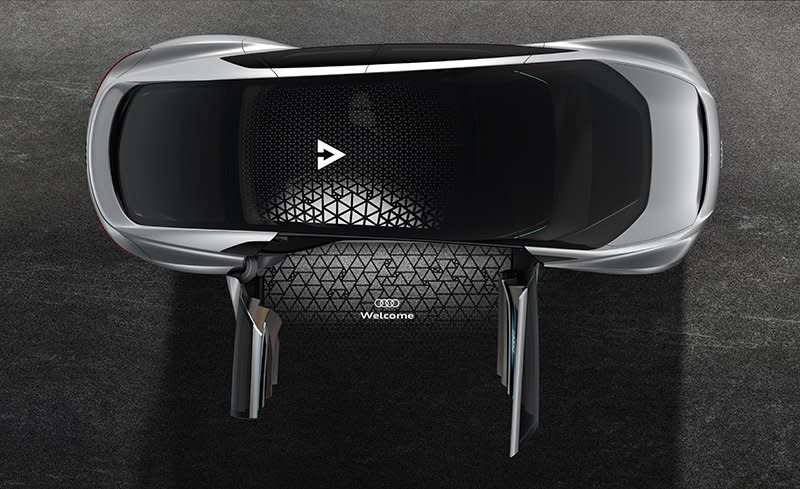
The Aicon also has a version of the Personal Intelligent Assistant, which “is often one step ahead of the passenger and offers services before they actively choose them.” The PIA’s wraparound interface has a haptic-manual layer, plus voice control and eye tracking, and occupants can work or watch movies via a front display or a virtual head-up image in the windshield, with the glass capable of blacking out the interior for a better picture—or naps. OLED lighting helps provide an interior ambience customized for the users.
Autonomous-vehicle technology, contrary to the some of the hype, will take many, many years to advance to the level assumed with the Aicon concept. As automakers push toward a future with ever higher levels of automated driving and as regulators work toward some big decisions, concept cars—especially ones like the Aicon—are useful visualizations of how it might take shape.

 Yahoo Autos
Yahoo Autos 